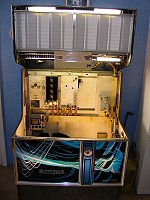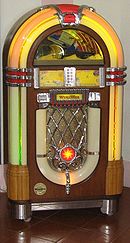- Jukebox
-
A jukebox is a partially automated music-playing device, usually a coin-operated machine, that will play a patron's selection from self-contained media. The classic jukebox has buttons with letters and numbers on them that, when entered in combination, are used to play a specific selection.
Contents
History
Coin-operated music boxes and player pianos were the first forms of automated coin-operated musical devices. These instruments used paper rolls, metal disks, or metal cylinders to play a musical selection on the instrument, or instruments, enclosed within the device. In the 1890s these devices were joined by machines which used actual recordings instead of physical instruments.[1][2] In 1890, Louis Glass and William S. Arnold invented the nickel-in-the-slot phonograph, the first of which was an Edison Class M Electric Phonograph retrofitted with a device patented under the name of Coin Actuated Attachment for Phonograph. The music was heard via one of four listening tubes.[3] Early designs, upon receiving a coin, unlocked the mechanism, allowing the listener to turn a crank which simultaneously wound the spring motor and placed the reproducer's stylus in the starting groove. Frequently exhibitors would equip many of these machines with listening tubes (acoustic headphones) and array them in "phonograph parlors" allowing the patron to select between multiple records, each played on its own machine. Some machines even contained carousels and other mechanisms for playing multiple records. Most machines were capable of holding only one musical selection, the automation coming from the ability to play that one selection at will. In 1918 Hobart C. Niblack patented an apparatus that automatically changed records, leading to one of the first selective jukeboxes being introduced in 1927 by the Automated Musical Instrument Company, later known as AMI. In 1928, Justus P. Seeburg, who was manufacturing player pianos, combined an electrostatic loudspeaker with a record player that was coin operated, and gave the listener a choice of eight records.[4] This Audiophone machine was wide and bulky, and had eight separate turntables mounted on a rotating Ferris wheel-like device, allowing patrons to select from eight different records. Later versions of the jukebox included Seeburg's Selectophone, with 10 turntables mounted vertically on a spindle. By maneuvering the tone arm up and down, the customer could select from 10 different records.[3]
Greater levels of automation were gradually introduced. As electrical recording and amplification improved there was increased demand for coin-operated phonographs.
The term "jukebox" came into use in the United States around 1940, apparently derived from the familiar usage "juke joint", derived from the Gullah word "juke" or "joog" meaning disorderly, rowdy, or wicked.[5]
Song-popularity counters told the owner of the machine the number of times each record was played (A and B side were generally not distinguished), with the result that popular records remained, while lesser-played songs could be replaced.
Wallboxes were an important, and profitable, part of any jukebox installation. Serving as a remote control, they enabled patrons to select tunes from their table or booth. One example is the Seeburg 3W1, introduced in 1949 as companion to the 100-selection Model M100A jukebox. Stereo sound became popular in the early 1960s, and wallboxes of the era were designed with built-in speakers to provide patrons a sample of this latest technology.
Initially playing music recorded on wax cylinders, the shellac 78 rpm record dominated jukeboxes in the early part of the 20th century. The Seeburg Corporation introduced an all 45 rpm vinyl record jukebox in 1950 leading to the 45 rpm record becoming the dominant jukebox media for the last half of the 20th century. 33⅓-R.P.M., C.D.s, and videos on DVDs were all introduced and used in the last decades of the century. MP3 downloads, and internet-connected virtually unlimited playlists came in the new, 21st century. The jukebox's history has followed the wave of technological improvements in music reproduction and distribution.
Jukeboxes were most popular from the 1940s through the mid-1960s, particularly during the 1950s. By the middle of the 1940s, three-quarters of the records produced in America went into jukeboxes.[6] While often associated with early rock and roll music, their popularity extends back much further, including classical music, opera and the swing music era. In 1977, The Kinks recorded a song called "Jukebox Music" for their album Sleepwalker.
Styling progressed from the plain wooden boxes in the early thirties to beautiful light shows with marbelized plastic and color animation in the Wurlitzer 850 Peacock of 1941. But after the United States entered the war, metal and plastic were needed for the war effort. Jukeboxes were considered "nonessential", and none were produced until 1946. The 1942 Wurlitzer 950 featured wooden coin chutes to save on metal. At the end of the war, in 1946, jukebox production resumed and several "new" companies joined the fray.
Models designed and produced in the late 20th century needed more panel space for the increased number of record titles they needed to present for selection, reducing the space available for decoration, leading to less ornate styling in favor of functionality and less maintenance.
Many manufacturers produced jukeboxes, including 1890s Wurlitzer, 1920s Seeburg, 1930s "Rock-Ola" whose name is actually based on that of the company founder, David Cullen Rockola, and Crosley.
Notable models
- 1946 Wurlitzer Model 1015 --- referred to as the "1015 bubbler" offered 24 selections. More than 56,000 were sold in less than 2 years and it is considered a pop culture icon. Designed by Wurlitzer's Paul Fuller.[3]
- 1953 Seeburg M100C - This was the jukebox used in the credit sequences for the sit-com Happy Days. It played up to fifty 45 rpm records making it a 100-play. It was a very colorful jukebox with chrome glass tubes on the front, mirrors in the display, and rotating animation in the pilasters.
- Gables Kuro --- 4 or 5 are known to exist and are valued at US$125,000.
- Rock-Ola President --- only one known to exist and valued at at least US$150,000
- Rock-Ola Premier --- 15 known to exist and valued at US$20,000
- Wurlitzer 950 --- 75-90 known to exist and valued at US$35,000
- 1927 LINK --- valued at US$40,000 and extremely rare.
Demise
Jukeboxes once received the newest songs first. They played music on demand without commercials. They offered a means to control the music listened to beyond what was available through the technology of their heyday.[3]
Jukeboxes seem to have been superseded by personal digital audio players, and the easy and free access to music on demand. There is less incentive to pay a jukebox to reproduce music.
While jukeboxes maintain popularity in bars they have fallen out of favor with what were once their more lucrative locations—restaurants, diners, military barracks, video arcades and laundromats.
References
- ^ SF Weekly - story on Louis Glass, Dec. 1, 1999
- ^ Great Geek Manual - Glass/Arnold patents
- ^ a b c d Weiss, Brett. Rock on with vintage jukeboxes. Antique Week. 2010-10-28. URL:http://www.antiqueweek.com/Article.asp?newsid=1796. Accessed: 2010-10-28. (Archived by WebCite at http://www.webcitation.org/5tp7pXdAm)
- ^ Carlisle, Rodney (2004). Scientific American Inventions and Discoveries, p.357. John Wiley & Songs, Inc., New Jersey. ISBN 0-471-24410-4.
- ^ "Juke house". Dictionary.com. http://dictionary.reference.com/browse/juke+house?jss=0.
- ^ Cowen, Tyler (2000). In praise of commercial culture. Harvard University Press. pp. 164, 166. ISBN 0674001885.
External links
- BAL-AMI Jukeboxes Home of the British-made BAL-AMI Jukeboxes
- Seeburg, Ami, Rockola, and Wurlitzer information and photos on most models
- Jukebox France Jukebox France
- Jukeboxes on location: photos, postcards, pictures - yesterday and today
- Noncommercial Site with survey of Jukebox Mechanics, Companies and Aesthetics
- JukeBoxes from the 1950s 1950s Jukebox
Formats Categories:- Musical culture
- Audio engineering
Wikimedia Foundation. 2010.





